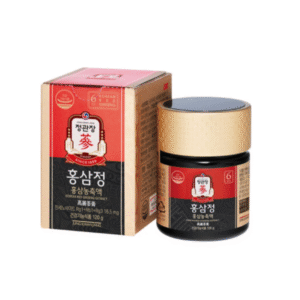🔬 Introduction: Why Mitochondria Matter More Than Ever
Mitochondria are the energy currency factories of the human body, generating ATP to power everything from cognition and muscle movement to immune function and cardiovascular health. When mitochondrial function declines, the result is not just fatigue — but a systemic loss of vitality that affects metabolism, mental performance, inflammation control, and long-term disease risk.
Modern research suggests that mitochondrial dysfunction underlies conditions such as:
- Chronic fatigue & burnout
- Metabolic syndrome & insulin resistance
- Age-related decline
- Immune dysregulation
- Neurodegenerative disorders
- Poor exercise tolerance
- Cardiovascular disorders
This brings us to Korean Red Ginseng (Panax ginseng C.A. Meyer) — a traditional herb now backed by modern mitochondrial science. While most discussions of ginseng focus only on ginsenosides, emerging research reveals that its bioactive molecules influence mitochondrial biogenesis, oxidative defense, ATP production, and cellular stress responses.
⚙️ How Korean Red Ginseng Supports Mitochondria at the Cellular Level
1. Activation of AMPK: The Metabolic Master Switch
AMPK is a key signaling enzyme that increases energy availability when the cell is under stress.
Ginsenosides – particularly Rg1 and Rb1 – have been shown to activate AMPK, which leads to:
- Enhanced fatty acid oxidation
- Improved glucose uptake
- Balanced energy utilization
- Increased mitochondrial biogenesis
- Improved metabolic flexibility
This is one reason Korean Red Ginseng is being investigated for metabolic syndrome and chronic fatigue support.
2. Upregulating SIRT1 and PGC-1α: The Longevity Axis
PGC-1α is the master regulator of mitochondrial biogenesis. SIRT1 activates PGC-1α and helps control:
- Number of mitochondria
- Efficiency of ATP synthesis
- Anti-inflammatory gene expression
- Cellular stress resistance
- DNA repair
Ginseng supports SIRT1/PGC-1α signaling, contributing to healthier aging and improved endurance.
3. Increasing ATP Production & Cellular Energy Output
Research shows that Korean Red Ginseng and isolated ginsenosides may:
- Enhance ATP synthesis efficiency
- Reduce mitochondrial membrane damage
- Improve electron transport chain function
- Upregulate oxidative phosphorylation
This means more usable energy at the cellular level — especially relevant for chronic fatigue, post-viral burnout, and autoimmune-related fatigue.
4. Antioxidant Defense & Mitochondrial Protection
Mitochondria produce free radicals as a natural byproduct. Excessive oxidative stress damages mitochondrial DNA, proteins, and membrane integrity.
Korean Red Ginseng provides antioxidant protection through mechanisms such as:
✔ Upregulation of endogenous antioxidants (SOD, CAT, GPx)
✔ Increased mitochondrial glutathione levels
✔ Improved ROS scavenging
✔ Prevention of mitochondrial apoptosis
This is essential in long-term mitochondrial stability and slowing the effects of aging.
5. Prevention of Mitochondrial Apoptosis
When mitochondria experience too much damage, cells initiate programmed death (apoptosis). Ginseng has been shown to:
- Prevent mitochondrial membrane depolarization
- Inhibit excess cytochrome c release
- Modulate caspase pathways
- Increase cell survival signaling
This mechanism combines antioxidant, anti-inflammatory, and anti-aging effects in one.
6. Improved Mitochondrial Dynamics: Fusion & Fission Balance
Healthy cells constantly remodel their mitochondria. Ginseng may help support:
- Mitochondrial fusion (repair + recovery)
- Controlled fission (removal of damaged segments)
- Stimulated mitophagy (targeted cleanup of dysfunctional mitochondria)
This keeps mitochondrial networks functional, resilient, and youthful.
🧠 Why Mitochondrial Benefits Matter for Whole-Body Performance
🧬 Aging & Longevity
Improved SIRT1/PGC-1α activity = slower cellular aging + better metabolic function.
💪 Chronic Fatigue & Energy Recovery
Mitochondrial ATP support = deeper, non-stimulant energy restoration.
🧠 Brain Health & Cognitive Endurance
Neurons require massive ATP — mitochondrial support translates directly to better focus, memory, and neurotransmitter balance.
❤️ Cardiovascular Protection
Ginseng supports ATP production, nitric oxide activation, and vascular flexibility.
🔥 Metabolic Function & Weight Regulation
Better mitochondrial signaling = improved fat burning and glucose utilization.
🛡 Immune System Resilience
Immune cells depend on mitochondrial energy to function — especially T-cells.
🧪 Key Ginsenosides for Mitochondrial Health
| Ginsenoside | Key Actions |
|---|---|
| Rg1 | AMPK activation, anti-fatigue, mitochondrial biogenesis |
| Rb1 | Improves ATP synthesis, protects neurons |
| Rg3 | Anti-inflammatory, protects mitochondrial membranes |
| Rh2 | Autophagy regulation, anti-proliferative |
| Compound K | Improves insulin sensitivity, gut-bioactivation |
| Rg5 & Rk1 | Found mainly in red ginseng, support oxidative defense |
Red ginseng contains more bioactive ginsenosides due to steaming conversion — one major reason it is considered superior for mitochondrial support vs white ginseng.
🌍 Traditional Wisdom Meets Modern Bioenergetics
Traditional East Asian medicine perceived fatigue, weakness, low immunity, and slow recovery as Qi deficiency — which in today’s biochemical understanding aligns closely with mitochondrial dysfunction.
This convergence between ancient concepts and modern molecular biology is one reason red ginseng is now being studied as an adaptogen for cellular resilience.
⚠️ Notes on Safety and Google Health Compliance
Korean Red Ginseng is:
- Not a drug
- Not used to treat, cure, or prevent disease
- Not a substitute for medical care or prescribed therapy
It may support healthy biological function, energy metabolism, and cellular resilience, but individuals with medical conditions should consult a professional before use.







